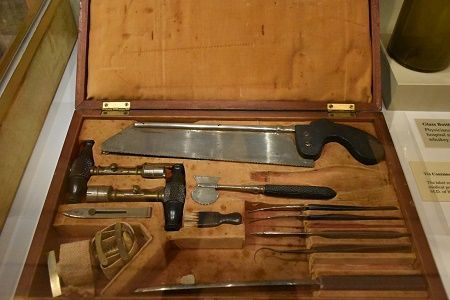Article
Civil War Medicine Museum Highlights the Era's Surprising Medical Achievements
Author(s):
The Civil War is known for its bloodiness and its massive death toll. However, a Maryland museum shows physicians did amazing work to limit the devastation.

A display showing a soldier on a stretcher. Photo by Candyce H. Stapen
Civil War medicine? To many that’s an oxymoron, especially after bombardment by period movies and westerns with scenes of wounded men biting on sticks while unqualified “surgeons” hack off bleeding legs. But as a sign outside the National Museum of Civil War Medicine, Frederick, MD, states “It’s not what you think.”
That proved engaging enough for me to enter. And I am glad I did. The museum highlights how doctors and caregivers who served during the war created innovations that “brought America out of the medical dark ages and into modern medicine.”
The exhibits detail those changes and present interesting facts. For example, recruiters rejected “Caleb,” missing a big toe, because that loss affected his ability to endure long marches while Edwin, blind in his left eye, received approval because he could use his right eye to aim a weapon. Of the nearly 620,000 soldiers who died, two-thirds died of disease versus one-third who perished from wounds.

A Civil War surgeon's kit. Photo by Candyce H. Stapen
Some of the Civil War innovations that morphed into modern medical procedures include:
• Developing a field transportation system. Dr. Jonathan Letterman, the Medical Director of the Army of the Potomac, created a transport system of stretchers and ambulances that brought the wounded from battlefields to care stations/hospitals. The system led to the modern ambulance system.
• Instituting care for animals. Veterinarian-staffed infirmaries were established to care for wounded and worn down horses and mules, animals that were essential to the army.
• Establishing a system of triage. For the first time, caregivers at field hospitals divided the wounded into three categories, mortally wounded, slightly wounded, and surgical candidates.
• Accepting hospitals. “Prior to the Civil War, any system of hospitalization was virtually unknown,” an exhibit states. The success of large hospitals led to the post-war acceptance of hospitals as places of healing.
• Use of embalming. Surgeons and pharmacists used embalming to preserve soldiers bodies so they could be shipped home for burial. Prior to the Civil War, embalming was little used in the U.S.
The museum also debunks Civil War medicine myths, including:
• The “butcher surgeon.” Most were trained doctors. What accounted for the prevalent loss of limbs wasn’t the poor skill of the surgeon but the severity of wounds caused by the new rifle technology and the Minnie ball.
• The lack of anesthetics. Although battle hospitals could sometime lack supplies, 95% of Civil War surgeries used chloroform or ether to anesthetize the patient to the point of not feeling severe pain.
If this piques your interest, tune in to the museum’s podcasts on Civil War medicine.
It’s appropriate that the Frederick, an hour’s drive from Washington, DC, serves as the home of the museum. During the Civil War the area endured three Confederate invasions, 38 skirmishes, and two major battles—South Mountain and Monocacy—resulting in legions of wounded soldiers and civilians.
What are your favorite medical museums? Comment below or connect with me on Twitter, @familyitrips.




